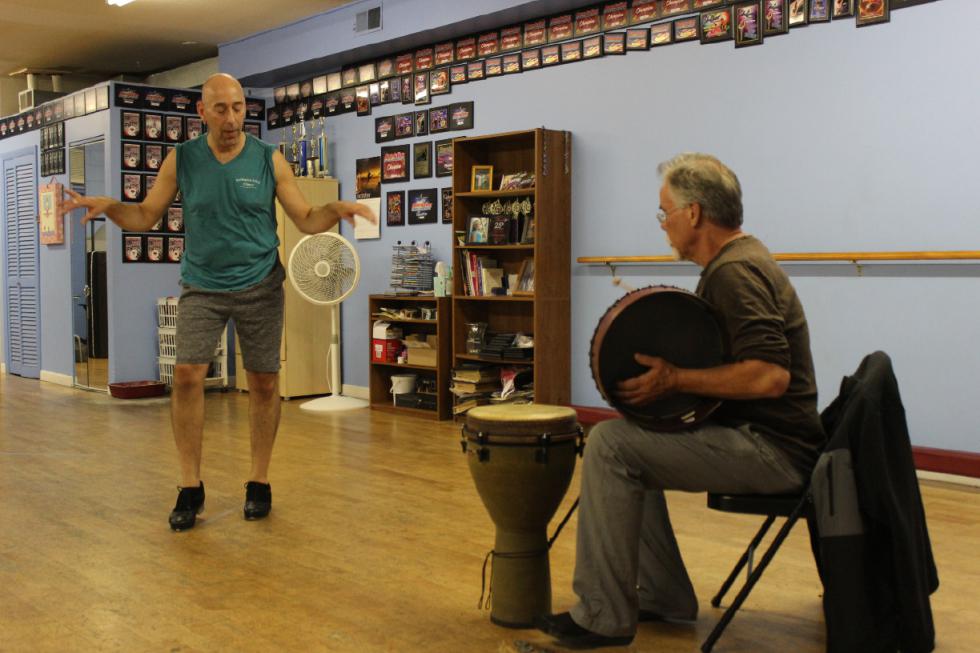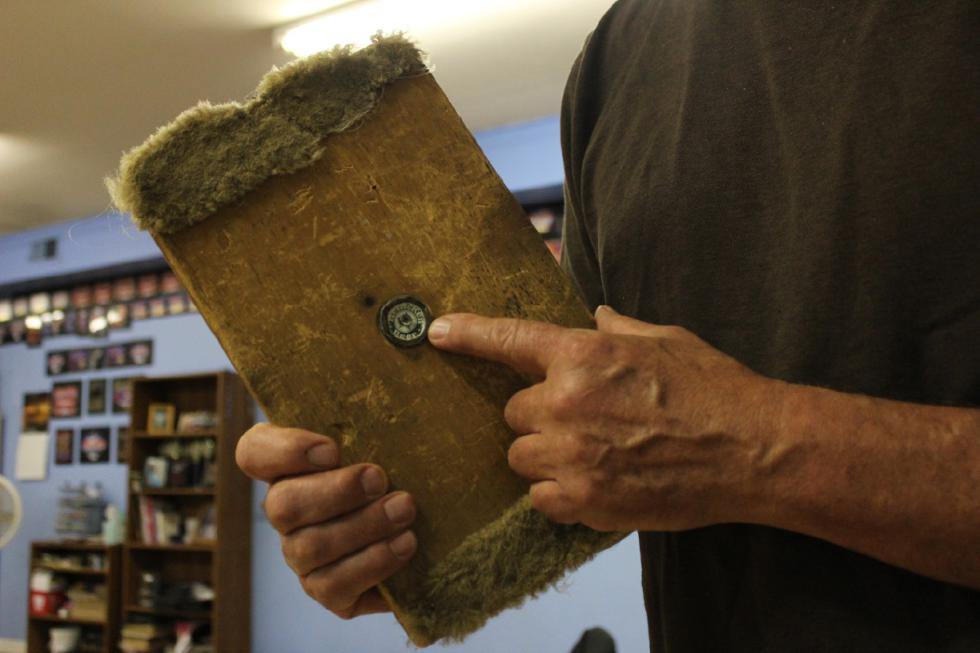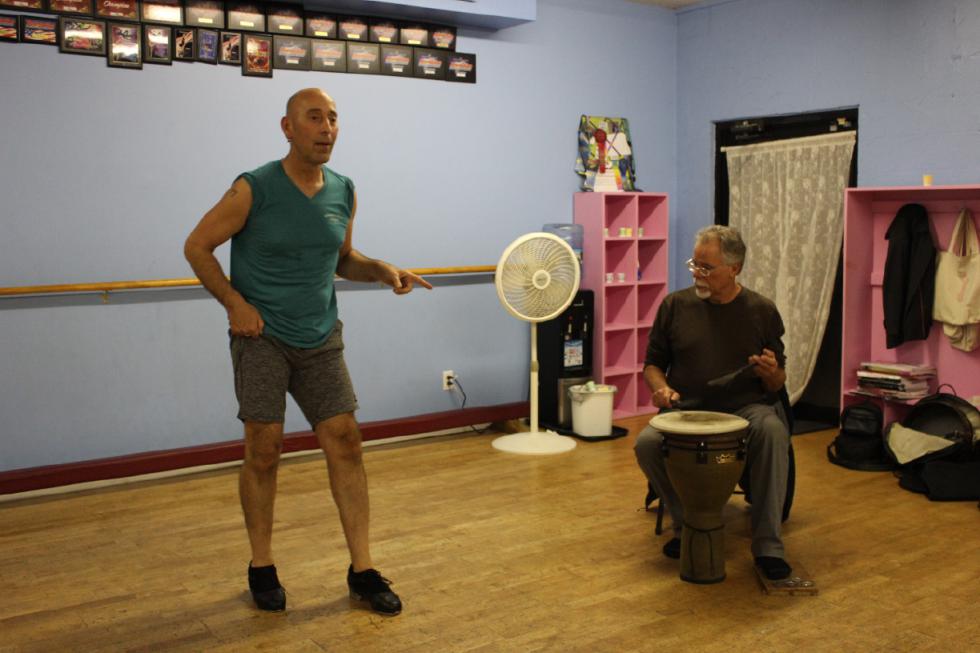Within seconds of meeting each other, tap and jazz dancer David Bovat and percussionist Jeff Hinrichs are moving and grooving. Hinrichs lays down a quick tempo on the djembe, which makes a deep, hollow sound, and Bovat’s tap shoes start click-clacking in double time.
“Nice, nice, nice. I like the way you play,” Bovat says to Hinrichs. “Of course I’m not rehearsed. I have no idea what I’m doing.”
The duo has little more than two weeks to merge themselves into a unified act for Live Art Magazine at the Academy of Music, Oct. 23. Going in, I’m shocked they’ve waited this long to have their first rehearsal, but when Hinrichs begins to play and Bovat to dance, I realize these guys are seasoned pros. Two weeks for these two will be more than enough time.
Live Art Magazine is an annual 90-minute live art performance curated and presented in a magazine format. Don’t bother Googling photos or YouTube clips from the first two events — you won’t find them. Live Art Magazine intentionally lives only in memory, through conversation, and in sketches. A “drawing team” occupies the front row during the live event just as sketch artists document courtroom proceedings. The event is a testbed, a space to try the most daring, new work artists only consider in their “wildest dreams.” It’s intended to nurture uninhibited creativity, bolstered by the knowledge that artists won’t find themselves on the Internet the next morning.
Organizer Amanda Herman says she felt inspired to start the annual Live Art event after seeing a pop-up mag in San Francisco. She moved to the Valley three years ago for family reasons and realized it was the perfect kind of event to bring here.
“I knew right away I had to connect with people who are from here,” Herman says, remembering how she had to seek out artistic advisors, who still play an integral role in the production. She found Dre Rawlings, a “creative guru” and new owner of the Ashfield Lake House, early on. And she went and saw a lot of art. “Sci-Tech just blew me away,” Herman says of her first interaction with the high school band from Springfield. “They always fill the theater with such joy.” On Oct. 23, the 150-member advanced band will open the event for the third year running.
Herman, who works part-time as a professor and also does freelance film and curation work, invites Valley artists to make pitches and then chooses acts accordingly. Performances by specially featured artists are slightly longer than others — about five minutes instead of two to three. Sponsorships allow Herman to support featured artists with a stipend. Ticket sales at the Academy of Music cover the cost of the venue and the Academy’s staff — who, Herman says, are instrumental in ensuring the live event goes off without a hitch.
Herman structures the night’s proceedings in the same fashion a magazine editor strives to create an editorial movement from page to page. “We really try to create an arc of emotions,” says Herman. “My role — the part I like most — is creating that flow.”
Then, with breath held, Herman watches the live event from the audience, waiting to see how and if these wild acts of art come together.
It was Herman’s idea to bring Bovat and Hinrichs together.
Getting into the groove
As I arrive at the Northampton School of Dance, Bovat, 50, finishes up a Broadway-style jazz dance class he’s teaching. The Springfield native has been dancing since he was 7. He works for five different dance studios in the Valley and runs the dance program at Bay Path College. On the weekends, he judges dance competitions around the globe.
Hinrichs, 58, of Northampton has been passionate about music since childhood. “From the minute I saw the Beatles on the Ed Sullivan Show that’s the only thing that ever mattered.”
Hinrichs picks up gigs where he can and plays frequently with the Expandable Brass Band and Kitchen Party. Technology has not been kind to musicians, says Hinrichs, who once gigged full-time but now works as a tradesman to supplement his income. “So I like the concept of ‘you have to be there.’”
Hinrichs brings along his bodhran — a short, fat drum that looks like a tambourine without the cymbals — and the djembe, a taller drum with a concave base.
Hinrichs and Bovat instantly adapt to each other, accommodating each change in tempo.
“If I started to go all crazy quick,” starts Bovat. “You could follow me, right?” Hinrichs nods emphatically, telling him he’s done a lot of work with dancers.
“So what should my entrance be like?” Bovat asks him.
“I was thinking of starting out with a jazz brush thing,” Hinrichs responds.
Bovat gestures his approval and his feet start flying across the floor again. These interludes are clearly a lot of work and Bovat amasses a growing circle of sweat at the center of his shirt. “I feel like when something moves me I can kind of roll with it,” says Bovat after Hinrichs kicks the tempo up a notch. “You’re following me, right?”
“Yeah, I’m following you,” Hinrichs responds. “And I’m trying to give you something to go off of.”
In between hitting and brushing the djembe, Hinrichs taps his foot on a wooden block, which clangs to the tap.
“I call this the ching ching,” Hinrichs says, bringing his homemade device over for a closer look. He says he made it after he ran over his tambourine about 15 years ago. “The Heineken bottle cap, here, is key to the whole thing.”
Bovat asks Hinrichs for a few minutes’ worth of drum beat and sets his phone to record. He says that to choreograph this wouldn’t work, but using this recording he’ll be able to break out the highlights.
Bovat concedes that most of his work is strictly choreographed so this will be a challenge. “I think it will be invigorating — the whole off-the-cuff feel,” says Bovat. “I wanted to do it because it was different for me. This is going to be challenging for me and I like that.”
Hinrichs, on the other hand, is very familiar with improvisational performance. “The most fun gigs are when I’m totally flying by the seat of my pants,” he says.•
Contact Amanda Drane at adrane@valleyadvocate.com





